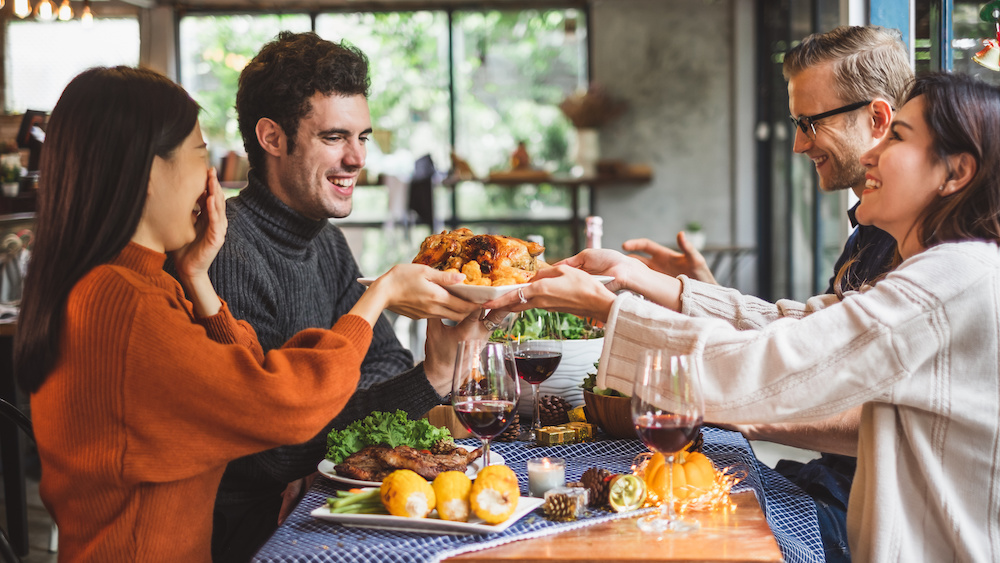By: Dr. Kim Feinstein, Psy.D., Red Mountain Clinical Psychologist and Behavioral Weight Loss Specialist
Download a printable version of this resource by clicking here.
Every day we are overwhelmed with eating “cues” — triggers that influence what we eat and how much we eat.
DID YOU KNOW?
We make over 200 food related decisions every day, and are often made mindlessly according to a study from Cornell University.
There are many reasons why we eat that that have nothing to do with satisfying our physiological needs but are actually being triggered by social, external, and internal cues. Once you become aware of your personal food triggers, you can begin to manage these cues and eventually overcome them.
3 Types of Eating Cues
1. Social Cues
When our social environment triggers us to behave in a certain way, we call that a social cue. Think about the social cues in your life that prompt you to eat unhealthily.
Examples:
- Are you more likely to eat around certain family members or friends?
- Do you tend to overeat at parties or special occasions?
- Do you mindlessly munch when you are conducting business over a meal?
- Do you give in when being urged to eat by a food pusher?
How to manage social cues:
Avoid the cue
In the beginning, it may be easier to avoid socializing until you learn how handle it. For example, if you routinely meet a group of friends for happy hour, and you always order drinks and appetizers, it may be best to avoid having happy hour with them for a while until you learn how to cope with the cue. Explore alternative ways to socialize with friends and family.
Have a plan
If you can’t avoid socializing, you will need to have a plan to successfully stay on track. Look at the menu beforehand and decide what you will consume before you arrive. Also, if you have to be around others who overeat and you are tempted to do so, get up and take a break in the middle of your meal to remind yourself of your plan. Remind yourself that you can have fun without eating and you are not missing out.
Practice responding to offers of unhealthy food
Remember: “No thank you” is a complete sentence!
You may have to say “no thank you” more than once to get your message across. If the food pusher harasses you and asks why, all you need to say is, “I’m taking more control over what I eat.” You are in control!
Monitor your alcohol consumption
Drinking alcohol can interfere with your reasoning, lower your inhibitions, and cause you to overeat. If you choose to drink, try to keep your alcohol consumption to one serving.
2. External Cues
Certain external environments can stimulate the urge to eat when you are not hungry. We call this an external cue. Think about the external cues in your life that prompt you to eat unhealthily.
Examples:
Are you triggered to eat…
- At the sight or smell of food
- By a specific food
- At particular places (i.e. in the kitchen, at buffets, while driving in the car)
- While engaged in specific activities (i.e. while watching TV, when on the computer)
- At certain times of the day (i.e. during your work break, arriving home from work, after dinner, before bedtime)
- After seeing an advertisement for food or eating
How to manage external cues:
Break the TV/Screen Behavior Pattern
If you are eating while watching television or while scrolling on your computer/smartphone, you are most likely paying more attention to what is happening on the screen than what you are putting into your mouth. This is called mindless eating.
Mindless eating not only makes food less satisfying, but it also leads to overeating, and chances are you are missing cues that you have eaten enough.
If you really feel that you must have a snack while watching a screen, plan it out. Avoid sitting in front of the TV with a whole bag of anything! It may also be helpful to do something else with your hands. Find an activity that will keep your hands busy, like knitting, painting your nails, squeezing a stress ball, or using a fidget spinner.
Use the “Out of Sight, Out of Mind” Strategy
Sometimes the old adage, “out of sight, out of mind,” can be extremely useful for you to keep in mind! Change your environment based on what you’ve recognized about your environmental triggers.
For instance, if your office break room is filled with baked goodies & your colleague has an enticing candy bowl, can choose to avoid these areas. Or, if you are aware that one of your environmental triggers is seeing (or smelling) a fast food restaurant while driving to/home from work, then it’s time to create a detour and find an alternative route.
A big obstacle to staying on track can also be the goodies available right in your own kitchen. When that box of cookies or bag of chips calling you from the pantry it can be difficult to resist. For many, not having those treats in the house, or at least not within view, is enough to turn down the dial on temptation. As such, be sure to clear out the cupboards and pantry or unhealthy choices — this will result in your best chance for meal plan compliance and weight loss success.
3. Internal Cues
There are three types of internal cues that cause us to eat inappropriately. These include emotions, thoughts, and physiological issues.
Emotions
Eating when you are experiencing negative emotions such as loneliness, anger, or sadness, stress, anxiety, or boredom, in the absence of physical hunger, is called emotional eating. Emotions are the most common internal cue for eating when not physically hungry.
Are you an emotion-driven eater?
- Do you self-medicate your moods with food?
- Is your motivation to eat healthy reduced when you are tired?
- Are you eating absent-mindedly, as if someone else is shoving those cookies or chips into your mouth?
Thoughts
Often times, our thoughts trigger our urge to eat when we are not physically hungry. The way you think—how you talk to yourself, the beliefs you hold, your memories, and your expectations—have a powerful influence on your eating habits.
Are you a thought-driven eater?
You think of excuses to yourself about why it’s OK to eat, such as:
- I deserve this…
- But, I have been good all week…
- I can’t waste this food…
- I have to have it…
- Who cares…
Physiological
Are you a physiological-driven eater?
Do you consume unhealthy food when you are:
- Experiencing pain or physical discomfort?
- Experiencing trembling, headache, or light-headedness?
- Experiencing fatigue or feeling over-tired?
How to manage internal cues:
Be Aware
Keep a journal of your emotions in order to become self-aware regarding your eating patterns. For instance, do you find yourself habitually reaching for certain foods when you are mad, sad, or even happy?
Develop positive self-talk
Our thoughts directly affect our behaviors. Therefore, it is necessary to think positively about your weight loss journey. Write down your weight loss goals and desires and refer to them often to help you stay focused on what you want.
When self-defeating thoughts creep into your mind, refer to your list of goals and remind yourself that you are capable of success.
Follow the 5 Ds
Avoid a downward spiral into emotional eating by enacting the 5 Ds method:
- Begin by delaying your urge to indulge. Research suggest that cravings often subside after 25-30 minutes. After this time period, you may find that you are no longer inclined to emotionally eat.
- Distract yourself with something pleasurable that does not involve food.
- Distance yourself from the food that you are craving by going to another room, going on a walk, or otherwise.
- If the aforementioned strategies have not helped, determine the answers to the following questions:
- How will indulging make me feel in the long-term?
- Will eating this food contribute to my long-term success?
- Finally, decide what your next steps will be. If you choose to indulge, do so mindfully – ask yourself the following:
- How much am I going to eat?
- Where am I going to eat?
- How fast am I going to eat?
Looking for a partner to help guide you through your weight loss journey? Request a weight loss appointment online to meet with one of our licensed medical providers.

Dr. Kim Feinstein, Psy. D. is a Licensed Clinical Psychologist and Red Mountain’s Behavioral Weight Loss Specialist. She specializes in weight management, body image concerns, and eating disorders & prides herself in her ability to educate, guide, and inspire patients to overcome obstacles and ultimately achieve their goals.

















